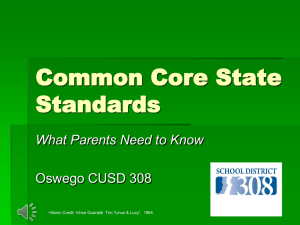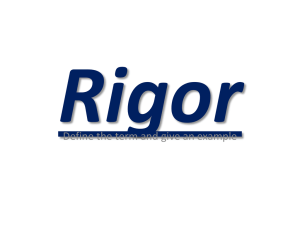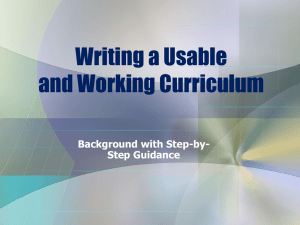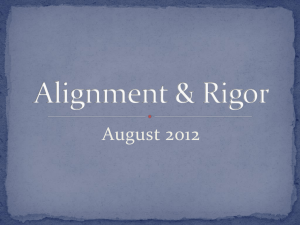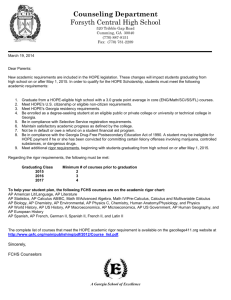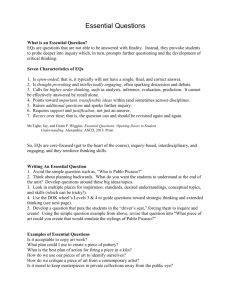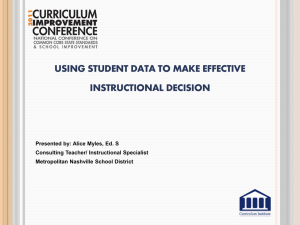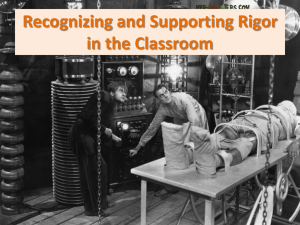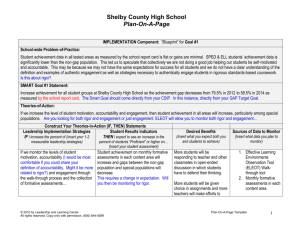rigor
advertisement
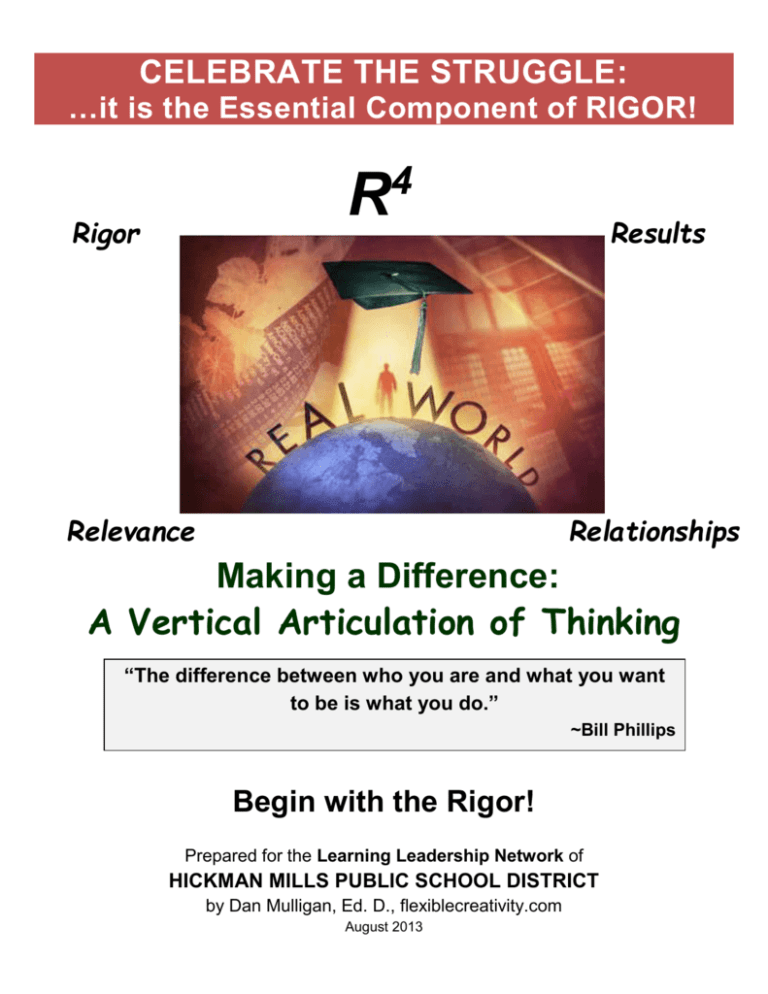
CELEBRATE THE STRUGGLE: …it is the Essential Component of RIGOR! R Rigor 4 Relevance Results Relationships Making a Difference: A Vertical Articulation of Thinking “The difference between who you are and what you want to be is what you do.” ~Bill Phillips Begin with the Rigor! Prepared for the Learning Leadership Network of HICKMAN MILLS PUBLIC SCHOOL DISTRICT by Dan Mulligan, Ed. D., flexiblecreativity.com August 2013 3 TABLE OF CONTENTS Vertical articulation of Collaboration 2 Rigor: Depth of Thinking 5 Rigor: Type of Thinking 10 Common Core Math Standards: Overview 14 Common Core Math Process Standards 15 Effective Feedback 19 Depth of Knowledge (Universal Design) 23 Depth of Knowledge: Language Arts/Math/Primary 27 Cognitive Rigor Matrix for Comprehensive ELA Assessment 28 Framework for Instructional Planning 31 Notes Page 41 Sample Essential Vocabulary 42 Administrators’ Role in RIGOR 43 Functional Text 47 Habits of Mind 48 RIGOR = TYPE of THINKING + DEPTH of THINKING DEPTH OF KNOWLEDGE Depth of THINKING This body of work offers the Depth of Knowledge (DOK) model employed to analyze the cognitive expectation demanded by standards, curricular activities, and assessment tasks (Webb, 1997). The model is based upon the assumption that curricular elements may all be categorized based upon the cognitive demands required to produce an acceptable response. Each grouping of tasks reflects a different level of cognitive expectation, or depth of knowledge, required to complete the task. It should be noted that the term knowledge, as it is used here, is intended to broadly encompass all forms of knowledge (i.e. procedural, declarative, etc.). The following table reflects an adapted version of the model. DOK Level Title of Level 1 Recall & Reproduction 2 Basic Skills & Concepts 3 Strategic Thinking & Reasoning 4 Extended Thinking As an administrator/teacher reflect on the level of thinking experienced by students by the ‘conclusion’ of most unit learning in your school. Where are you currently? Where do we want to be? How will you get there? 5 RECALL AND REPRODUCTION Curricular elements that fall into this category involve basic tasks that require students to recall or reproduce knowledge and/or skills. The subject matter content at this particular level usually involves working with facts, terms and/or properties of objects. It may also involve use of simple procedures and/or formulas. There is little transformation or extended processing of the target knowledge required by the tasks that fall into this category. Key words that often denote this particular level include: list, identify and define. A student answering a Level 1 item either knows the answer or does not; that is, the answer does not need to be “figured out” or “solved.” POSSIBLE PRODUCTS QUIZ DEFINITION FACT WORKSHEET TEST LABEL LIST COLLECTION PODCAST WORKBOOK EXPLANATION REPRODUCTION SHOW AND TELL CATEGORIZING/ TAGGING COMMENTING VOCABULARY QUIZ OUTLINE BULLETING RECITATION BLOG HIGHLIGHTING EXAMPLE WIKI SOCIAL NETWORKING SOCIAL BOOKMARKING SEARCHING GOOGLING ROLES STUDENT TEACHER DIRECTS TELLS RESPONDS ABSORBS SHOWS EXAMINES REMEMBERS RECOGNIZES QUESTIONS EVALUATES MEMORIZES DESCRIBES DEMONSTRATES LISTENS EXPLAINS TRANSLATES COMPARES CONTRASTS RESTATES DEMONSTRATES EXAMINES INTERPRETS NOTES TO SELF: 6 BASIC SKILLS AND CONCEPTS This level generally requires students to contrast or compare people, places, events and concepts; convert information from one form to another; classify or sort items into meaningful categories ; describe or explain issues and problems, patterns , cause and effect, significance or impact, relationships, points of view or processes. A Level 2 “describe or explain” would require students to go beyond a description or explanation of recalled information to describe or explain a result or “how” or “why.” The learner should make use of information in a context different from the one in which it was learned. POSSIBLE PRODUCTS PHOTOGRAPH INTERVIEW LINKING SOLVE MIND MAPS PRESENTATION BLOG COMMENTING ILLUSTRATION CRACKING CODES REVERSEENGINEERING BLOG REFLECTING SIMULATION PERFORMANCE MODERATING SCULPTURE DEMONSTRATION EXPLAIN CATEGORIZE GENERALIZE TRANSLATE ESTIMATE JOURNAL ROLES STUDENT TEACHER SHOWS FACILITATES SOLVE PROBLEMS OBSERVES EVALUATES CALCULATES DEMONSTRATES USE OF KNOWLEDGE COMPILES ORGANIZES QUESTIONS COMPLETES ILLUSTRATES CONSTRUCTS NOTES TO SELF: 7 STRATEGIC THINKING & REASONING Items falling into this category demand a short-term use of higher order thinking processes, such as analysis and evaluation, to solve real-world problems with predictable outcomes. Stating one’s reasoning is a key marker of tasks that fall into this particular category. The expectation established for tasks at this level tends to require coordination of knowledge and skill from multiple subject-matter areas to carry out processes and reach a solution in a project-based setting. Key processes that often denote this particular level include: analyze, explain and support with evidence, generalize, and create. POSSIBLE PRODUCTS GRAPH SPREADSHEET CHECKLIST EVALUATING SURVEY DEBATE CONCLUDE PODCAST DATABASE PANEL PROGRAM PUBLISHING REPORT FILM CHART ABSTRACT ANIMATION OUTLINE INVESTIGATE VIDEO CAST ROLES STUDENT TEACHER PROBES GUIDES DISCUSSES UNCOVERS OBSERVES EVALUATES DEBATES THINKS DEEPLY ACTS AS A RESOURCE QUESTIONS EXAMINES QUESTIONS ORGANIZES DISSECTS JUDGES DISPUTES CLARIFIES ACCEPTS ASSESSES DECIDES JUSTIFIES TESTS SELECTS COMPARES GUIDES NOTES TO SELF: 8 EXTENDED THINKING Curricular elements assigned to this level demand extended use of higher order thinking processes such as synthesis, reflection, assessment and adjustment of plans over time. Students are engaged in conducting investigations to solve real-world problems with unpredictable outcomes. Employing and sustaining strategic thinking processes over a longer period of time to solve the problem is a key feature of curricular objectives that are assigned to this level. Key strategic thinking processes that denote this particular level include: synthesize, reflect, conduct, and manage. POSSIBLE PRODUCTS FILM PLAN PROJECT NEW GAME NEWSPAPER SONG MEDIA PRODUCT STORY ROLES STUDENT TEACHER FACILITATES EXTENDS DESIGNS FORMULATES REFLECTS ANALYZES TAKES RISKS MODIFIES PROPOSES PLANS EVALUATES CREATES NOTES TO SELF: 9 TYPE of THINKING 11 15 16 17 Rigor-Infused Math Inquiry: FACILITATING MATH-TALK Questions I currently use to guide and encourage student thinking: Questions I can add to my toolkit: What then is effective feedback? “The most powerful single moderator that enhances achievement is feedback” Quality feedback should: • focus on the learning intention of the task John Hattie. University of Auckland. 1999 Inaugural • occur as the students are doing the learning • provide information on how and why the student understands and misunderstands • provides strategies to help the student to improve • assist the student to understand the goals of the learning Key Research Findings When feedback is corrective in nature—that is, it explains where and why students have made errors--significant increases in student learning occur (Lysakowski & Walberg, 1981, 1982; Walberg, 1999; Tennenbaum & Goldring, 1989). Feedback has been shown to be one of the most significant activities a teacher can engage in to improve student achievement (Hattie, 1992). Asking students to continue working on a task until it is completed and accurate (until the standard is met) enhances student achievement (Marzano, Pickering, & Pollock, 2001). Effective feedback is timely. Delay in providing students feedback diminishes its value for learning (Banger-Drowns, Kulik, Kulik, & Morgan, 1991). Administer tests to optimize learning. Giving tests a day after a learning experience is better than testing immediately after a learning experience (Bangert-Downs, Kulik, Kulik, & Morgan, 1991). Rubrics provide students with helpful criteria for success, making desired learning outcomes clearer to them. Criterion-referenced feedback provides the right kind of guidance for improving student understanding (Crooks, 1988; Wilburn & Felps, 1983). Effective learning results from students providing their own feedback, monitoring their work against established criteria (Trammel, Schloss, & Alper, 1994; Wiggins, 1993). Additional Resources RubiStar is a free online tool that teachers can use to make and save rubrics. Developed by the High Plains Regional Technology in Education Consortium, RubiStar includes a tutorial for new users and a feature that enables teachers to analyze student data and identify areas for focusing additional instruction. http://rubistar.4teachers.org/index.php The National Center for Research on Cultural Diversity and Second Language Learning has published an article called The Instructional Conversation: Teaching and Learning in Social Activity. The authors discuss the use of modeling, providing feedback, contingency management, directing, questioning, explaining, and task structuring in classroom activity settings.http://www.ncela.gwu.edu/pubs/ncrcdsll/rr2.htm 19 20 22 Depth of THINKING Depth of Knowledge (DOK) Levels for MATHEMATICS DOK Level 1 (Recall) includes the recall of information such as fact, definition, term, or a simple procedure, as well as performing a simple algorithm or applying a formula. That is, in mathematics a one-step, well-defined, and straight algorithmic procedure should be included at this lowest level. Other key words that signify a Level 1 include "identify," "recall," "recognize," "use," and "measure." Verbs such as "describe" and "explain" could be classified at different levels depending on what is to be described and explained. Level 2 (Skill/Concept) includes the engagement of some mental processing beyond a habitual response. A Level 2 assessment item requires students to make some decisions as to how to approach the problem or activity, whereas Level 1 requires students to demonstrate a rote response, perform a well-known algorithm, follow a set procedure (like a recipe), or perform a clearly defined series of steps. Keywords that generally distinguish a Level 2 item include "classify," "organize," "estimate," "make observations," "collect and display data," and "compare data." These actions imply more than one step. For example, to compare data requires first identifying characteristics of the objects or phenomenon and then grouping or ordering the objects. Some action verbs, such as "explain," "describe," or "interpret" could be classified at different levels depending on the object of the action. For example, if an item required students to explain how light affects mass by indicating there is a relationship between light and heat, this is considered a Level 2. Interpreting information from a simple graph, requiring reading information from the graph, also is a Level 2. Interpreting information from a complex graph that requires some decisions on what features of the graph need to be considered and how information from the graph can be aggregated is a Level 3. Caution is warranted in interpreting Level 2 as only skills because some reviewers will interpret skills very narrowly, as primarily numerical skills, and such interpretation excludes from this level other skills such as visualization skills and probability skills, which may be more complex simply because they are less common. Other Level 2 activities include explaining the purpose and use of experimental procedures; carrying out experimental procedures; making observations and collecting data; classifying, organizing, and comparing data; and organizing and displaying data in tables, graphs, and charts. 24 Level 3 (Strategic Thinking) requires reasoning, planning, using evidence, and a higher level of thinking than the previous two levels. In most instances, requiring students to explain their thinking is a Level 3. Activities that require students to make conjectures are also at this level. The cognitive demands at Level 3 are complex and abstract. The complexity does not result from the fact that there are multiple answers, a possibility for both Levels 1 and 2, but because the task requires more demanding reasoning. An activity, however, that has more than one possible answer and requires students to justify the response they give would most likely be a Level 3. Other Level 3 activities include drawing conclusions from observations; citing evidence and developing a logical argument for concepts; explaining phenomena in terms of concepts; and using concepts to solve problems. Level 4 (Extended Thinking) requires complex reasoning, planning, developing, and thinking most likely over an extended period of time. The extended time period is not a distinguishing factor if the required work is only repetitive and does not require applying significant conceptual understanding and higher-order thinking. For example, if a student has to take the water temperature from a river each day for a month and then construct a graph, this would be classified as a Level 2. However, if the student is to conduct a river study that requires taking into consideration a number of variables, this would be a Level 4. At Level 4, the cognitive demands of the task should be high and the work should be very complex. Students should be required to make several connections-relate ideas within the content area or among content areas-and have to select one approach among many alternatives on how the situation should be solved, in order to be at this highest level. Level 4 activities include designing and conducting experiments; making connections between a finding and related concepts and phenomena; combining and synthesizing ideas into new concepts; and critiquing experimental designs. 25 Mathematics Item Depth of Knowledge Indicators DOK 1 RECALL Examples represent, but do not constitute all Level 1 mathematics performances: Recall or recognize a fact, ,definitions, or term Apply a well-known algorithm Apply a formula Determine the area or perimeter of rectangles or triangles given a drawing and labels Identify a plane or three dimensional figure Measure a length Perform a specified or routine procedure Evaluate an expression Solve a one-step word problem Retrieve information from a table or graph Recall, identify, or make conversions between and among representations or numbers (fractions, decimals, and percents), or within and between customary and metric measures Locate numbers on a number line, or points on a coordinate grid Solves linear equations Represent math relationships in words, pictures, or symbols DOK 2 SKILL/CONCEPTS DOK 3 STRATEGIC THINKING DOK 4 EXTENDED THINKING Examples represent, but do not Examples represent, but do not constitute all Level 2 mathematics constitute all Level 3 performances: mathematics performances: Examples represent, but do not constitute all Level 4 mathematics performances: Classify plane and three dimensional figures Interpret information from a simple graph Use models to represent mathematical concepts Solve a routine problem requiring multiple steps, or the application of multiple concepts Compare figures or statements Compare and contrast figures Provide justifications for steps in a solution process Extend a pattern Retrieve information from a table, graph, or figure and use it solve a problem requiring multiple steps Translate between tables, graphs, words and symbolic notation Select a procedure according to criteria and perform it Relate mathematical concepts to other content areas Relate mathematical concepts to real-world applications in new situations Apply a mathematical model to illuminate a problem, situation Conduct a project that specifies a problem, identifies solution paths, solves the problem, and reports results Design a mathematical model to inform and solve a practical or abstract situation NOTE: Level 4 requires applying one approach among many to solve problems. Involves complex restructuring of data, establishing and evaluating criteria to solve problems. Interpret information from a complex graph Explain thinking when more than one response is possible Make and/or justify conjectures Develop logical arguments for a concept Use concepts to solve problems Perform procedure with multiple steps and multiple decision points Generalize a pattern Describe, compare, and contrast solution methods Formulate a mathematical model for a complex situation Provide mathematical justifications Solve a multiple- step problem, supported with a mathematical explanation that justifies the answer Formulate an original problem, given a situation Using Depth of Knowledge Following are some questions to consider when analyzing your curriculum tasks for DOK. 1. What level of work are the students most commonly required to perform? 2. What is the complexity of the task rather than the difficulty? 3. What are all the skills and knowledge scaffolding that the students will have already needed to build to complete the task? Examples of what Depth of Knowledge ‘sound-like’ in the classroom Content Area Elementary Language Arts Level 1 Sort known words as quickly as possible Elementary Math Collect data on the number of teeth lost by students in one 2nd grade classroom. Elementary Interdisciplinary List the ingredients of a peanut butter and jelly sandwich. Level 2 Find words in text that illustrate a defined pattern. Level 3 Create an open sort and define the rule and explain. Organize these Using the graph, data using a grph predict how many or chart (e.g., a line teeth would be lost by plot all the 2nd grade classes in the school and justify your answer Collect the Investigate how many ingredients for a people are coming to peanut butter and dinner and formulate jelly sandwich and the appropriate write the recipe. amounts of ingredients for that many people. Level 4 Illustrate through authentic writing stability in pattern and content of identified stages. Create a model to estimate how many teeth are lost be 2nd grade students in the United States in one year. Include the type of data needed to collect and explain how your model works. Research and design a system to lift heavy objects using the conversion of electrical energy to mechanical energy. Build a prototype of the system using materials found in the classroom. 27 29 30 32 33 34 35 36 37 38 39 40 Personal Reflections Dan Mulligan Flexiblecreativity.com 41 42 The Role of the Administrator in RIGOR for ALL: Few people question the need for America’s schools and classrooms to be more rigorous. But there is little agreement about what rigor is and what it looks like. In Rigor is NOT a Four-Letter Word, Barbara Blackburn defined rigor as creating an environment in which each student is expected to learn at high levels, each student is supported so that he or she can learn at high levels, and each student demonstrates learning at high levels (Blackburn, 2008). This three-part approach assures that rigor doesn’t consist of just adding curriculum requirements or raising grading standards. Integral to the model is providing every student with high levels of support so that they can thrive and be successful in their classrooms. Rigor is more than a specific lesson or instructional strategy. It is deeper than what a student says or does in response to a lesson. Real rigor is the result of weaving together all elements of schooling to improve the achievement and learning of every student. Expectations We’ll start with the first part: rigor is creating an environment in which each student is expected to learn at high levels. Having high expectations starts with the decision that every student possesses the potential to be his or her best, no matter what. Almost everyone we talk with says that they have high expectations for their students. Sometimes that is evidenced by the behaviors in the school; at other times, actions don’t match the words. When you visit classrooms and work with your teachers, consider using the following tools to assess the level of rigor you see. As you work with teachers to design lessons that incorporate more rigorous opportunities for learning, you will want to consider the questions that are embedded in the instruction. Higher-level questioning is an integral part of a rigorous classroom. Look for open-ended questions that are at the higher levels of Bloom’s Taxonomy (analyze, evaluate, create). It is also important to look at how teachers respond to student questions. It is not uncommon for teachers who ask higher-level questions to accept low-level responses from students. In rigorous classrooms, however, teachers push students to respond at high levels. They ask extending questions. If a student does not know the answer, the teacher continues to probe and guide the student to an appropriate answer rather than moving on to the next student. My thoughts regarding my school: 43 Tool 1: Questions and Responses You can use this tally tool to chart your observations about questioning techniques and talk with teachers about questions in class. QUESTIONS ASKED BY TEACHER Low-level/rote questions High-level/application questions TEACHER RESPONSE TO STUDENT ANSWERS Low-level student responses accepted High-level responses accepted or probing/extended questions asked Supports (rigor with nurturing) High expectations are important, but the most rigorous schools also ensure that each student is supported so he or she can learn at high levels, the second part of our definition. It is essential that teachers design lessons that move students to more challenging work while simultaneously providing ongoing scaffolding to support students learning as they those higher levels. Providing additional scaffolding throughout lessons is one of the most important ways to support students. This can occur in a variety of ways, but it requires that teachers ask themselves during every step of their lesson, “What extra support might my students need?” 44 Tool 2: Scaffolding in Lessons Examples of scaffolding strategies include: Asking guiding questions Chunking information Color-coding the steps of a project Writing standards as questions for students to answer Using visuals and graphic organizers Providing such tools as interactive reading guides, study guide. Demonstration The third component of a rigorous classroom provides each student with opportunities to demonstrate learning at high levels. We often hear that if teachers provide more challenging lessons that include extra support, then learning will happen. If we want students to show us that they understand what they learned at a high level, we also need to provide opportunities for students to demonstrate that they have truly mastered that learning. One way to accomplish that is through increased student engagement. Student engagement is a key aspect of rigor. In too many classrooms, most of the instruction consists of the teacher-centered large group instruction, perhaps in an interactive lecture or discussion format. The general practice during these lessons is for the teacher to ask a question, and then call on a student to respond. Although this provides an opportunity for one student to demonstrate their understanding, the remaining students don’t have the opportunity to do so. Another option would be for the teacher to allow all students to respond either through pair-share (talk to your shoulder partner), writing answers on small whiteboards and sharing their responses, or responding on a handheld computer that tallies responses. Such activities hold each student accountable for demonstrating his or her understanding. Tool 3: Student Engagement Negative Indicators Positive Indicators One student responds Two or three students discuss content Teacher asks students if they understand, and they answer with a simple yes or no; there is no probing. All students respond All students discuss content in small groups All students write a response in a journal or exit slip 45 When you talk with your teachers about their instructional practices, you can also ask them about engagement and how they design lessons to promote positive student engagement and high levels of student accountability for demonstrating learning. Tool 4: Talking with Teachers Talk with me about how you make your lessons engaging. What information do you use to guide your decisions? As you design your lessons, what are some of the strategies you use to make sure the lesson is engaging to students? While teaching a lesson, how do you monitor the engagement of your students? As you continue to work on student engagement, what would you identify as the most appropriate next steps? What may I do to support you in your work to improve student engagement? Final Thoughts and Action Planning Recognizing rigor in classrooms is all about recognizing good instruction. It is important to look for instructional practices that expect students to learn at very high levels and that also give students the support to achieve at high levels. It is also essential that teachers expect all students to demonstrate their learning at high levels. 46 47 48
